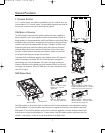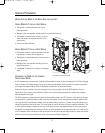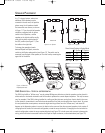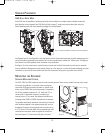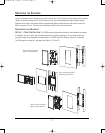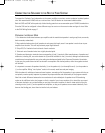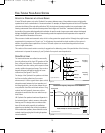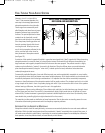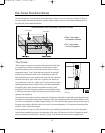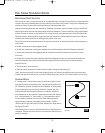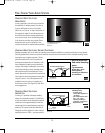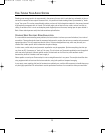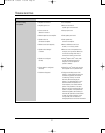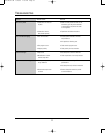
15
H
owever, since it is not possible to
“toe-in” flush-mounted speakers, the
next step is the strategic placement of
absorptive materials on the side walls.
These range from commercially avail-
able fiberglass and dense foam to heavy
draperies and even large, overstuffed
furniture. The optimal position for these
materials can be found with a small
hand mirror and the help of an assistant.
Sit at the primary listening position and
have the assistant slowly slide the mir-
ror along the wall. When you can see
any of the front speakers reflected in the
mirror, mark the wall at the mirror for
later placement of absorptive material
(see Figure 23).
A variation of this method is especially helpful in rooms that are already fairly “dead” acoustically. Rather than using
absorptive material in rooms like these, try using diffusion instead. Commercially built diffusers are available, but
large bookcases and irregularly shaped furniture will also serve the same purpose. They reflect sounds in a highly
random way that effectively “scatters” the sound in all directions. Place the diffuser where you would otherwise
place the absorptive material (using the “mirror trick”), to break up the first early reflections and scatter them
randomly throughout the room.
Commercially available fiberglass, foam and diffusion panels may not be aesthetically acceptable in many installa-
tions, particularly when the home theater room serves multiple purposes. All of these materials can be covered with
acoustically transparent cloth for design considerations. It is important that the cloth be acoustically transparent,
however, or the effectiveness of the absorptive material will be greatly reduced. The simplest test for this is to hold
a large sample of the cloth in front of a speaker playing pink noise. If you can move the cloth in front of the speaker
without hearing a difference, the cloth is good for use in this application.
Large expanses of glass can be challenging. Glass reflects mids and highs, but often lets bass pass through, almost
as if the glass were not there. The result is a characteristically bright, rough sound that can be difficult to correct
electronically. The best treatment is generally the heaviest insulated drapes that can be found. (Incidentally, these
serve double duty, controlling light that might otherwise fall on the screen.)
The materials just discussed are ineffective at lower frequencies. See the discussion on standing waves for more
information about treating environments with low-frequency response problems.
EXCESSIVE USE OF ABSORPTIVE MATERIALS
Absorptive materials should be used judiciously, as overuse can acoustically deaden the room and create additional
difficulties. While the ideal home theater should be considerably “deader” acoustically than a typical living room, it
still needs some reflectivity and diffusion. In particular, the surround speakers depend on nonabsorptive surfaces for
their operation, since they radiate virtually no sound directly at the listeners.
Loudspeaker
Listener
Direct Path
Re
fle
cte
d Pa
th
Reflected Path
L
oudspeaker
Re
fle
cte
d Pa
th
Re
fle
cte
d Pa
th
Listener
Direct Path
Absorptive Material Absorptive Material
SOLUTIONS TO ROOM REFLECTIONS:
DIFFUSION AND ABSORPTION
Figure 23.
FINE-TUNING YOUR AUDIO SYSTEM
S4VC/HC/Ai OM 2/28/06 4:55 PM Page 16



